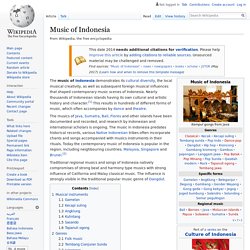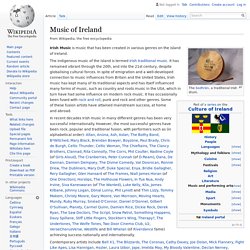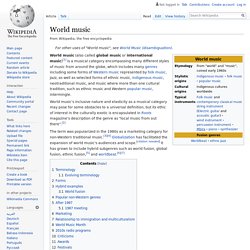

Log In to Canvas. Accéder à Hotmail, Outlook, l'actualité et plus-MSN France. Seven Historic Irish Musicians and Performers. Klezmer: Definition, Music & Instruments. KLEZMER MUSIC. Klezmer music originated in the 'shtetl' (villages) and the ghettos of Eastern Europe, where itinerant Jewish troubadours, known as 'klezmorim', performed at joyful events ('simkhes'), particularly weddings, since the early middle age till the Nazi and Stalinian prosecutions.

It was inspired by secular melodies, popular dances, 'khazones' (khazanut, Jewish liturgy) as well as by the 'nigunim', the simple and often wordless melodies, intended by the 'Hasidim' (orthodox Jews) for approaching God in a kind of ecstatic communion. In (mutual) contact with Slavic, Greek, Ottoman (Turkish), Gypsy and -later- American jazz musicians, using typical scales, tempo and rhythm changes, slight dissonance and a touch of improvisation, the 'klezmorim' acquired the ability to evoke all kinds of emotions, through a very diversified music. back home "Klezmer: it's not just music - it's a way of life! " (Hankus Netsky) A klezmer kapelye (~1910) Attention, please: Pronounce 'kleZmer' and not 'kleTzmer'! Feidman. Article about Music of Indonesia by The Free Dictionary.
(redirected from Music of Indonesia)Also found in: Wikipedia. one of the richest and most distinctive of Asian musical cultures.

It was and is of enormous importance in religious, political, and entertainment functions. It possesses two separate tonal systems—pélog and sléndro or salendro. Pélog contains seven tones, only five of which are used in a given composition. The intervals of pélog are unequal, and the smaller ones approximate the semitone of Western music. Bibliography See J. The Columbia Electronic Encyclopedia™ Copyright © 2013, Columbia University Press.
Music of Indonesia. The music of Indonesia demonstrates its cultural diversity, the local musical creativity, as well as subsequent foreign musical influences that shaped contemporary music scenes of Indonesia.

Nearly thousands of Indonesian islands having its own cultural and artistic history and character.[1] This results in hundreds of different forms of music, which often accompanies by dance and theatre. Traditional regional musics and songs of Indonesia natively compromises of strong beat and harmony type musics with strong influence of California and Malay classical music. The influence is strongly visible in the traditional popular music genre of Dangdut. Musical instruments[edit] Balinese gamelan performance. Music of Ireland. The bodhrán, a traditional Irish drum.

Irish Music is music that has been created in various genres on the island of Ireland. The indigenous music of the island is termed Irish traditional music. It has remained vibrant through the 20th, and into the 21st century, despite globalising cultural forces. In spite of emigration and a well-developed connection to music influences from Britain and the United States, Irish music has kept many of its traditional aspects and has itself influenced many forms of music, such as country and roots music in the USA, which in turn have had some influence on modern rock music. It has occasionally been fused with rock and roll, punk and rock and other genres. What is Celtic music? Japanese music. Japanese Traditional Music.
Traditional Japanese music usually refers to Japan's historical folk music.

One of the defining characteristics of traditional Japanese music is its sparse rhythm. Regular chords are also absent. It is impossible for a person to beat time to the music. All of the rhythms are ma-based, and silence is an important part of the songs. The focus is on creating music that flows in an attempt to mirror the behavior of nature. Article about African music by The Free Dictionary. Also found in: Wikipedia. the music of the indigenous peoples of Africa.

Sub-Saharan African music has as its distinguishing feature a rhythmic complexity common to no other region. Polyrhythmic counterpoint, wherein two or more locally independent attack patterns are superimposed, is realized by handclaps, xylophones, rattles, and a variety of tuned and nontuned drums. Music of Africa. Women from the Masai tribe, singing.

The music of Africa is as vast and varied as the continent's many regions, nations, and ethnic groups. The African continent comprises approximately 20 percent of the world's land mass and has a population of roughly 934 million. African music is as diverse as its cultures and peoples and has flowered in many indigenous forms as well as been shaped by foreign influences. Although there are many different varieties of music in Africa, there are a number of common elements to the music, especially within regions. The concept of music in Africa, especially in sub-Saharan Africa bears a difference from other regions and cultures.
African music also helps to connect people together in a variety of ways, strengthening the fabric of the community, which in turn reinforces people's commitment to support each other and the community, toward mutual health and prosperity. Music in the World of Islam: handasah al sawt. Salsa music. Conga drums, one of the foundational instruments of salsa music. Salsa as a musical term[edit] "In 1973, I hosted the television show Salsa which was the first reference to this particular music as salsa. I was using [the term] salsa, but the music wasn't defined by that. MUSIC ...around the world. World music. World music (also called global music or international music)[1] is a musical category encompassing many different styles of music from around the globe, which includes many genres including some forms of Western music represented by folk music, Jazz, as well as selected forms of ethnic music, indigenous music, neotraditional music, and music where more than one cultural tradition, such as ethnic music and Western popular music, intermingle.

World music's inclusive nature and elasticity as a musical category may pose for some obstacles to a universal definition, but its ethic of interest in the culturally exotic is encapsulated in Roots magazine's description of the genre as "local music from out there".[2] The term was popularized in the 1980s as a marketing category for non-Western traditional music.[3][4] Globalization has facilitated the expansion of world music's audiences and scope. Terminology[edit] The term has been credited to ethnomusicologist Robert E. Evolving terminology[edit]